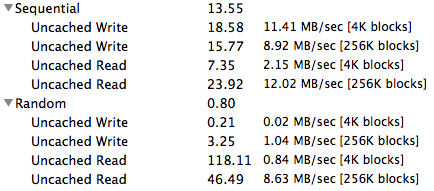My usual setup for listening to music is an iPod connected through a line out dock cable to a Fiio headphone amplifier, which powers AKG Q701s. So there’s certain limitations. Because LOD cables only work with the old 30-pin port, you have to use an older iPod; likewise, because I like to listen to music at night, in the dark, an older iPod is necessary to have physical buttons, so you don’t have to look at a bright screen. So you get a choice between the iPod Classic, which has a noisy, slow hard drive, and an iPod Nano, which tops out at 16 GB. I’ve used the Nano for a long time.

But I have a lot more music than the Nano holds, which has gotten a little annoying. I was thinking about getting an iPod Classic, but didn’t want a hard drive, or the really laggy interface the post-2007 iPods have used. Putting in a 1.8″ SSD fixes the first problem, but leaves the second, and adds a lot of cost (since you’re talking new iPod, then new SSD). And using an old used iPod (with the good B&W interface) is hard because they are universally beat to hell by now.
I remembered that, around the time I got my first DSLR, one of the cool things you could get was a Microdrive CompactFlash card, which held four gigs compared to 128 or 256 MB on a regular CF card. And because of Apple’s bulk purchasing, the cheapest way to get the Microdrive was actually to buy an iPod Mini, then harvest the Microdrive from it and throw away the rest. Given that iPod Minis were more robust than the big iPods, and that I had a spare 64 GB UHS-1 Micro SD card that I bought to use with an Nvidia Shield and forgot about, I decided to do the opposite, and throw away the Microdrive in favor of the SD card. Then you get the best of everything — fast OS, big solid-state storage, robust enclosure, 30-pin out with the good DSP, and a big click wheel.
There’s several guides to putting a CF card in an iPod Mini, but I wasn’t sure what would happen with this; the iPod uses CF cards natively, but I needed to go through a CF-to-SD adapter, then an SD-to-µSD adapter. So it’s a little hacky.
The only thing to really watch out for is to make sure you get the second-generation Mini, because the first-generation can’t play lossless audio.



That’s how you open them — spudge off the top and bottom covers, undo two screws and unplug the click wheel, then the rest just slides out. The last picture is the stock Microdrive and ancient battery in place.

…and there’s the adapter-pile and new battery in place, with some half-hearted tape to make sure it doesn’t jiggle inside. The new battery has 157% of the original’s capacity; given that the original could run the iPod for 18 hours, and given that the Microdrive probably uses a lot more power than the Micro SD card, I think this thing should give pretty awesome battery life.

Plugged in for testing before reassembly.

Aw yuss. Works perfectly, holds all my music, sounds great with the Fiio. Total cost was $90 — $65 for the Micro SD card (Sandisk Extreme Plus), $15 for the iPod, $10 for the new battery. All I want to do now is get a dark red gel filter and slip it between the screen and the screen-hole, to make the backlight nicer to use in the dark.

As a sidenote, me-of-ten-years-ago was really happy to peel a Microdrive apart. It is indeed a micro drive.





